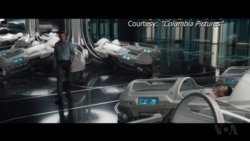In the new sci-fi film "Passengers," a team of earthlings undertakes a 120-year trip to colonize a new planet. But something goes wrong on the way. Scientists say while much of the movie is a work of fiction, some real science underpins many of its ideas.
For NASA scientist Tiffany Kataria, finding a habitable planet is not so far-fetched. She studies exoplanets – planets that orbit stars other than our sun.
"The ultimate goal with studying exoplanets is to really find an Earth twin, to find some other planet out there that’s earth-like that maybe eventually we can colonize some day and explore," Kataria said.
In the Sony Pictures (Columbia) film, the passengers travel on a spaceship that rotates. It's not just for show, aerospace engineer John Bradford explained.
Rotation creates artificial gravity, which can mitigate some of the damaging effects of extended time in a microgravity environment, including "bone demineralization and muscle atrophy," Bradford said. "Having this artificial gravity solves those problems, and rotating it is the best way to do it.”
Current technology is not sufficiently advanced to build a ship large enough to hold thousands of people, as the one portrayed in "Passengers," he said.
"The size of the ship is probably the big challenge, being able to create those large structures. Are you launching those from Earth? Are you building [the ships] in space?" Bradford asked rhetorically, calling the concept a "stretch for me. The hibernation and the propulsion aspect and things [are] probably less so."
Studying human hibernation
Bradford’s company, SpaceWorks Enterprises, is researching human hibernation, or stasis, as a possibility for flight to Mars.
On the International Space Station, a challenge "that they’re seeing right now is with increased intracranial pressure, and that is causing long-term damage on the astronauts' vision," Bradford explains. After a six-month stay, astronauts show "reduced vision when they come back. Actually cooling down the body, reducing the metabolism, reduces that intracranial pressure. It’s one of the treatments here on Earth."
Putting humans in a hibernating state also reduces food and oxygen requirements. Bradford said his company planned to test human stasis to gauge humans' reactions over relatively short periods. If they're deemed safe, the stasis time would be increased incrementally.
"Initially, we would maybe cycle through the crew [members] in two-week stints of being in stasis, and then they take turns waking up and then inducing the next person, waking them," Bradford explained. "Those two weeks are within current medical technology. It’s a limited data set, but that has been done before.
"But ultimately to get the full benefits we want to be able to go to five or six months, and that will take years – 15 years or so, 20 years – to really fully understand all the impacts on the crew," Bradford said. "But for the shorter stay and the shorter duration, these two-week cycles, we’re optimistic we could be ready to support the first missions to Mars. We've just got to convince NASA."
Distant dreams
As for human space flight beyond Mars and our solar system, that is where science ends and fiction begins.
Proxima b, the closest known earth-size exoplanet that might be habitable, is 4.2 light years away and would take "tens of thousands of years" to reach, Kataria said, comparing it to the Juno spacecraft orbiting Jupiter at 150,000 miles per hour (240,000 kph). "So, really, the technology still needs to make that leap, I think, to be able to achieve light-speed travel or close to light-speed travel. “
It may take years for technology to catch up to the imagination, but audiences can experience the excitement of space travel by going to movie theaters.







